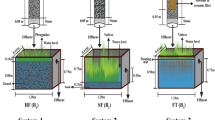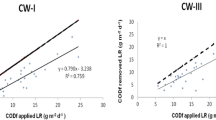Abstract
The study was initiated to evaluate constructed wetland technology as a method for treating alkaline (pH 8.0–8.6) drainage high in Al, Mo, V, As and Ga originating from bauxite residue storage areas. Pilot-scale horizontal flow constructed wetlands were operated over a 40-week period using three filter materials (granitic gravel, bauxite and alum water treatment sludge), and half of the wetlands were planted with Phragmites australis and the other half left unplanted. Gravel was the least effective medium for removing the target elements, while of the two active media, water treatment sludge was more effective than bauxite. Plants removed only small amounts of elements into their above- and below-ground dry matter (0.4–4.9% of that added). Nonetheless, the presence of plants greatly increased the effectiveness of all three media since their presence decreased effluent pH values by 0.5–1.3 pH units and that of the filter media by 0.4 pH units. Removal of elements followed the order Al > Ga > V > As > Mo. For planted wetlands, total elemental removal ranged from 18 to 98% for gravel, 80 to 99% for bauxite, and 93 to 99% for water treatment sludge. The lowest removal was for Mo (ranging from 18% for gravel to 93% for water treatment sludge) and the highest for Al (ranging from 98% in gravel to 99% in water treatment sludge). A sequential fractionation scheme for As, V and Mo on filter material at the end of the experiment showed that for bauxite and water treatment sludge, V and As were concentrated in the NaOH extractable fraction while Mo was concentrated in the less strongly adsorbed NaHCO3 extractable fraction. It was concluded that a constructed wetland with water treatment sludge as an active filter material is an effective technology for removal of the target elements from the alkali drainage.





Similar content being viewed by others
References
Ali I (2012) New generation adsorbents for water treatment. Chem Rev 112:5073–5091
Antoniadis A, McKinley JD, Zuhairi WYW (2007) Single-element and competitive metal mobility measured with column infiltration and batch tests. J Environ Qual 36:53–60
Bertsch PM, Bloom PR (1996) Aluminium. In: Sparks DL (ed) Methods of soil analysis, part 3–chemical methods. Soil Science Society of America, Madison, pp 517–550
Bloom PR, McBride MB, Weaver RM (1979) Aluminium organic matter in acid soil: buffering and solution aluminium activity. Soil Sci Soc Am J 43:488–493
Buckley R, Curtin T, Courtney R (2016) The potential for constructed wetlands to treat alkaline bauxite residue leachate: laboratory investigations. Environ Sci Pollut Res 23:14115–14122
CEM (1993) Microwave sample preparation note for banana leaves. Application Note AG 13. CEM Corporation, Mathews, North Carolina
Cross AF, Schlesinger WH (1995) A literature review and evaluation of the Hedley fractionation: applications to biogeochemical cycle of soil phosphorus in natural ecosystems. Geoderma 64:197–214
Department of Environment and Heritage Protection (2012) Tenth update on the water quality of Port Curtis and tributaries including data collected in the week of July. The State of Queensland, Brisbane, Australia, p 2012
Driscoll CT (1985) Aluminium in acidic surface waters: chemistry, transport and effects. Environ Health Perspect 63:93–104
Hagvall K, Persson P, Karlsson T (2014) Spectroscopic characterization of the coordination chemistry and hydrolysis of gallium (III) in the presence of aquatic organic matter. Geochim Cosmochim Acta 146:76–89
Haynes R (2015) Use of industrial wastes as media in constructed wetlands and filter beds–prospects for removal of phosphate and metals from wastewater streams. Crit Rev Environ Sci Technol 45:1041–1103
Haynes RJ, Swift RS (1989) The effects of pH and drying on adsorption of phosphate by aluminium-organic matter associations. J Soil Sci 40:773–781
Hedley MJ, Stewart JWB, Chauhan BS (1982) Changes in inorganic soil phosphorus fractions by cultivation practices and by laboratory incubations. Soil Sci Soc Am J 46:970–976
Higgins D, Curtin T, Courtney R (2017) Effectiveness of a constructed wetland for treating alkaline bauxite residue leachate: a 1-year field study. Environ Sci Pollut Res 24:8516–8524
Higgins D, Curtin T, Burke IT, Courtney R (2018) The potential for constructed wetlands mechanisms to treat alkaline bauxite residue leachate: carbonation and precipitate characterization. Environ Sci Pollut Res 25:29451–29458
Hua T, Haynes RJ (2016) Constructed Wetlands: fundamental processes and mechanisms for heavy metal removal from wastewater streams. Int J Environ Eng 8:148–178
Hua T, Haynes RJ, Zhou Y-F, Boullemant A, Chandrawana I (2015) Potential for use of industrial waste materials as filter media for removal of Al, Mo, As, V and Ga from alkaline drainage in constructed wetlands–adsorption studies. Water Res 71:32–41
Hua T, Haynes RJ, Zhou Y-F (2018a) Potential use of two filter media in constructed wetlands for simultaneous removal of As, V and Mo from alkaline wastewater-batch adsorption and column studies. J Environ Manag 218:190–199
Hua T, Haynes RJ, Zhou Y-F (2018b) Competitive adsorption and desorption of arsenate, vanadate and molybdate onto low-cost adsorbent materials alum water treatment sludge and bauxite. Environ Sci Pollut Res 25:34053–34062
Lee BH, Scholz M (2007) What is the role of Phragmites australis in experimental constructed wetland filters treating urban runoff. Ecol Eng 29:87–95
Li Y, Haynes RJ (2017) Formation, properties and revegetation prospects for bauxite processing residue and the effects of seawater neutralization. Int J Environ Eng 9:11–39
MacLeod LB, Jackson LB (1967) Water soluble and exchangeable aluminium in acid soils as affected by liming and fertilization. Can J Soil Sci 47:203–210
Marchland L, Mench M, Jacob DL, Otte ML (2010) Metal and metalloid removal in constructed wetlands, with emphasis on the importance of plants and standardized measurements: a review. Environ Poll 158:3447–3461
Martinie GD, Schilte AA (1976) Investigation of the wet oxidation efficiencies of perchloric acid mixtures for various organic substances and the identities of residual matter. Anal Chem 48:70–74
Mayes WM, Batty LC, Younger PL, Jarvis AP, Koiv M, Vohla C, Mander U (2009) Wetland treatment at extremes of pH: a review. Sci Total Environ 407:3944–3957
McLaren RG, Naidu R, Smith J, Tiller KG (1998) Fractionation and distribution of arsenic in soils contaminated by cattle dip. J Environ Qual 27:348–354
Menzies NW, Fulton IM, Kopittke RA, Kopittke PM (2009) Fresh water leaching of alkaline bauxite residue after sea water neutralization. J Environ Qual 38:2050–2057
Mucha AP, Almeida MR, Bordalo AA, Vasconcelos SD (2005) Exudation of organic acids by a marsh plant and implications on trace metal availability in the rhizosphere of estuarine sediments. Estuar Coast Shelf Sci 65:191–198
Music S, Wolf RHH (1979) Sorption of microamounts of gallium(III) on Fe(OH)3 and FeO3 precipitates. Mikrochim Acta 1:87–94
Power G, Grafe M, Klauber C (2011) Bauxite residue issues: 1. Current management, disposal and storage practices. Hydrometallurgy 108:33–45
Rayment GE, Higginson FR (1992) Australian laboratory handbook of soil and water chemical methods. Inkata Press, Melbourne
Regelink IC, Weng L, Lair GJ, Comans RNJ (2015) Adsorption of phosphate and organic matter on metal (hydr)oxides in arable and forest soil: a mechanistic modelling study. Eur J Soil Sci 66:867–875
Seo DC, Yu K, DeLaune RD (2008) Comparison of monometal and multimetal adsorption in Mississippi river alluvial wetland sediment: batch and column experiments. Chemosphere 73:1757–1764
Srivastava J, Swinder JS, Naraian R (2014) Environmental perspectives of Phragmites australis (Cav.) Trin. Ex. Steudel. Appl Water Sci 4:193–202
Stottmeister U, Wiessner A, Kuschk P, Kappelmeyer U, Kästner M, Bederski O, Müller R, Moormann H (2003) Effects of plants and microorganisms in constructed wetlands for wastewater treatment. Biotechnol Adv 22:93–117
Vymazal J (2011) Plants used in constructed wetlands with horizontal subsurface flow: a review. Hydrobiologia 674:133–156
Vymazal J, Svehla J, Kropfelova L, Chrastny V (2007) Trace metals in Phragmites australis and Phalaris arundinacea growing in constructed wetlands. Sci Total Environ 380:154–162
Weis JS, Weis P (2004) Metal uptake, transport and release by wetland plants: implications for phytoremediation and restoration. Environ Int 30:685–700
Wu J, Joergensen RG, Pommerening B, Chaussod R, Brookes PC (1990) Measurement of soil microbial biomass C by fumigation-extraction–an automated procedure. Soil Biol Biochem 22:1167–1169
Xue S, Zhu F, Kong X, Wu C, Huang L, Huang N, Hartley W (2016) A review of the characterization and revegetation of bauxite residues (red mud). Environ Sci Pollut Res 23:1120–1132
Zakikhani H, Yusop MK, Hanafi MM, Othman R, Soltangheisi A (2016) Sulphur and molybdenum fractionation in marine and riverine alluvium paddy soils. Chem Speciat Bioavailab 28:170–181
Author information
Authors and Affiliations
Corresponding author
Additional information
Responsible editor: Philippe Garrigues
Publisher’s note
Springer Nature remains neutral with regard to jurisdictional claims in published maps and institutional affiliations.
Rights and permissions
About this article
Cite this article
Hua, T., Haynes, R.J. & Zhou, YF. Removal of Al, Ga, As, V and Mo from alkaline wastewater using pilot-scale constructed wetlands. Environ Sci Pollut Res 26, 35121–35130 (2019). https://doi.org/10.1007/s11356-019-06490-3
Received:
Accepted:
Published:
Issue Date:
DOI: https://doi.org/10.1007/s11356-019-06490-3




